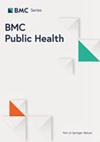2013-2020 年兰州市日气温、昼夜温差与哮喘住院率的相关性研究
IF 3.6
2区 医学
Q1 PUBLIC, ENVIRONMENTAL & OCCUPATIONAL HEALTH
引用次数: 0
摘要
在全球气候变化的背景下,气候变化对哮喘等呼吸道疾病的影响正受到越来越多的关注。然而,气温和昼夜温差(DTR)对哮喘的影响是复杂的,了解不同季节、年龄组和性别的这些影响至关重要。本研究利用中国兰州的哮喘住院数据,采用分布式滞后非线性模型(DLNM)来研究气温和昼夜温差与哮喘住院之间的关系。研究还考虑了不同季节和不同人群之间的影响差异。研究显示,低温会立即增加哮喘住院风险(RR = 1.2010,95% CI:1.1464, 1.2580),并且这种风险会持续一段时间。同时,温度过高和过低都与哮喘住院风险增加有关。在温暖季节,较低的气温(RR = 2.9798,95% CI:1.1154, 7.9606)与较高的哮喘风险相关,而在寒冷季节,普通人群(RR = 3.6867,95% CI:1.7494, 7.7696)、女性(RR = 7.2417,95% CI:2.7171, 19.3003)和老年人(RR = 18.5425,95% CI:5.1436, 66.8458)的哮喘风险显著上升。在温暖季节,低 DTR 条件与男性(RR = 7.2547,95% CI:1.2612, 41.7295)和 15-64 岁成年人(RR = 9.9494,95% CI:2.2723, 43.5643)的哮喘住院风险有显著关联。在特定的 DTR 范围内,儿童也表现出明显的风险。在寒冷季节,较低的 DTR 会增加一般人群哮喘住院的风险(RR = 3.1257,95% CI:1.4004,6.9767)。高 DTR 会明显增加成人哮喘的住院风险(RR = 5.2563,95% CI:2.4131,11.4498)。这项研究为了解气温、DTR 和哮喘住院治疗之间的复杂关系提供了重要依据,并强调了哮喘风险在不同季节和人口亚群中的差异。本文章由计算机程序翻译,如有差异,请以英文原文为准。
The correlation between daily temperature, diurnal temperature range, and asthma hospital admissions in Lanzhou city, 2013–2020
With the backdrop of global climate change, the impact of climate change on respiratory diseases like asthma is receiving increasing attention. However, the effects of temperature and diurnal temperature range (DTR) on asthma are complex, and understanding these effects across different seasons, age groups, and sex is of utmost importance. This study utilized asthma hospitalization data from Lanzhou, China, and implemented a distributed lag nonlinear model (DLNM) to investigate the relationship between temperature and DTR and asthma hospitalizations. It considered differences in the effects across various seasons and population subgroups. The study revealed that low temperatures immediately increase the risk of asthma hospitalization (RR = 1.2010, 95% CI: 1.1464, 1.2580), and this risk persists for a period of time. Meanwhile, both high and low DTR were associated with an increased risk of asthma hospitalization. Lower temperatures (RR = 2.9798, 95% CI: 1.1154, 7.9606) were associated with higher asthma risk in the warm season, while in the cold season, the risk significantly rose for the general population (RR = 3.6867, 95% CI: 1.7494, 7.7696), females (RR = 7.2417, 95% CI: 2.7171, 19.3003), and older individuals (RR = 18.5425, 95% CI: 5.1436, 66.8458). In the warm season, low DTR conditions exhibited a significant association with asthma hospitalization risk in males (RR = 7.2547, 95% CI: 1.2612, 41.7295) and adults aged 15–64 (RR = 9.9494, 95% CI: 2.2723, 43.5643). Children also exhibited noticeable risk within specific DTR ranges. In the cold season, lower DTR increases the risk of asthma hospitalization for the general population (RR = 3.1257, 95% CI: 1.4004, 6.9767). High DTR significantly increases the risk of asthma hospitalization in adults (RR = 5.2563, 95% CI: 2.4131, 11.4498). This study provides crucial insights into the complex relationship between temperature, DTR, and asthma hospitalization, highlighting the variations in asthma risk across different seasons and population subgroups.
求助全文
通过发布文献求助,成功后即可免费获取论文全文。
去求助
来源期刊

BMC Public Health
医学-公共卫生、环境卫生与职业卫生
CiteScore
6.50
自引率
4.40%
发文量
2108
审稿时长
1 months
期刊介绍:
BMC Public Health is an open access, peer-reviewed journal that considers articles on the epidemiology of disease and the understanding of all aspects of public health. The journal has a special focus on the social determinants of health, the environmental, behavioral, and occupational correlates of health and disease, and the impact of health policies, practices and interventions on the community.
 求助内容:
求助内容: 应助结果提醒方式:
应助结果提醒方式:


